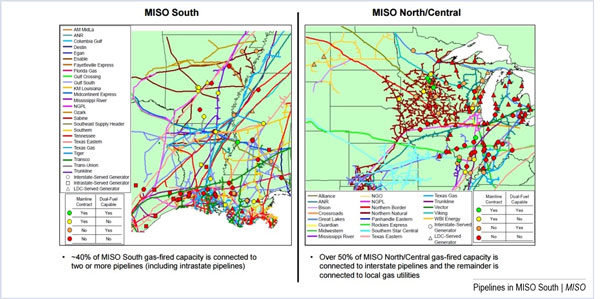By Amanda Durish Cook
CARMEL, Ind. — MISO will continue its efforts to improve gas-electric coordination in 2017, revealing a plan for the year that includes more data sharing, modeling and outreach.
The top 2017 goals include disclosing generators’ hourly gas usage profiles to gas system operators and improving modeling to identify future electric transmission and pipeline expansion needs. The RTO also plans on continuing to issue market updates to stakeholders and communicate with gas industry officials and regulators.
Other tasks include creating a gas generator database and NERC studies on gas contingencies, MISO strategy adviser Scott Wright told the Resource Adequacy Subcommittee on Nov. 30.
MISO will launch a pilot project to share two or three generators’ day-ahead gas usage profiles with gas system operators. The RTO will use its day-ahead clearings to forecast hourly gas usage. Wright noted that FERC Order 787 enables sharing of nonpublic operational information with gas pipelines for “reliability and operational planning.”
Indianapolis Power and Light’s Lin Franks said the RTO has done “a fine job” so far in getting pipeline and gas resource owners to communicate, such as providing real-time pipeline restrictions and notifications.
But she cautioned the RTO against involving itself in fuel contracts between gas suppliers and generators and said MISO’s gas role should be limited to providing operational data transparency and not influencing new products or rules.
“None of these contracts are exactly alike,” Franks said. “Managing our fuel supply is our obligation, not MISO’s. We’ve got to be very careful here that MISO doesn’t insert itself in our ability to manage our fuel supply. It is our job to ensure adequate supply to our generation. This one seems to be ripe for a fight on jurisdiction.”
Wright said the main thrust behind the coordination is fuel assurance. “By no means [are we] thinking that we’re going to get in between a generator and its pipeline. It’s, ‘Are there ways to unlock efficiencies in the gas coordination market?’”
Wright said he didn’t understand stakeholder concerns that gas was being treated differently than coal in terms of fuel assurance. “Why gas and not coal? I find it befuddling the references to the coal pile,” Wright said. “Gas is different. All of these pipelines are FERC-regulated. Coal is off by itself.”
MISO houses about 200 gas-fired generators and more than 30 pipelines. Gas resources, which currently comprise 42% of its generation fleet, will rise to 50% in the coming years, according to the RTO.
In October, gas was 12.8% of the dispatched generation fuel mix in MISO’s Central Region, versus 5.4% of the mix in MISO North and 63.4% of that in MISO South.
“The outlook of gas is it will grow, and in some ways MISO is catching up. There’s going to be a lot of gas demand growth in MISO North and Central,” predicted Wright.
Gas Generators Ready for Winter
Gas system operators reported a “high level” of winter preparedness in The RTO’s third winter generator fuel survey. MISO Electric Gas Operations Coordinator Mark Thomas said 174 gas-fired facilities (representing 63,600 MW, 87% of the RTO’s gas-fired capacity), participated in the survey.
The survey reported connections to more than 30 gas systems in the footprint, with approximately 46,550 MW, or 65% of MISO gas capacity, connected directly to intrastate and interstate pipelines. About 70% of MISO North/Central gas capacity is connected to just five pipelines through direct connect or local distribution companies. MISO found 40% of gas-fired capacity (28,900 MW) had firm transportation and/or dual-fuel capability. “Though an increase from the previous survey, questions remain as MISO expects gas reliance to grow,” the RTO said.
The RTO also found that 42% of responding capacity (30,850 MW) subscribes to no-notice services and 37% of capacity (27,340 MW) has access to firm or interruptible storage.
However, Thomas said 11% of responding generators said they did not have a detailed weatherization plan, including insulation, wind breaks and equipment shelters. He said it was “surprising” that so many did not have a plan in place and wondered whether the question was worded clearly enough.





